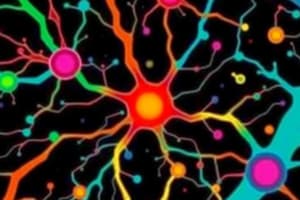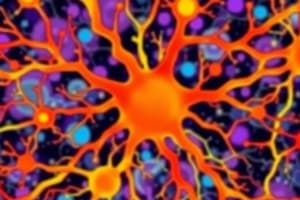Podcast
Questions and Answers
What is the goal of the perceptron in classifying a set of inputs?
What is the goal of the perceptron in classifying a set of inputs?
- To minimize the sum of its inputs
- To maximize the sum of its inputs
- To output a random value for each input
- To correctly classify inputs into one of two classes (correct)
What happens when the perceptron updates its weights?
What happens when the perceptron updates its weights?
- It updates continuously regardless of errors
- It never updates its weights
- It updates randomly
- It only updates when erring (correct)
Why is the perceptron sensitive to noise?
Why is the perceptron sensitive to noise?
- It converges quickly despite misclassified samples
- A single misclassified sample could abolish its convergence (correct)
- It makes small weight changes for misclassified samples
- It ignores misclassified samples
What is the role of synapses in neural networks?
What is the role of synapses in neural networks?
What was derived for the maximal number of iterations until convergence for linearly separable classes?
What was derived for the maximal number of iterations until convergence for linearly separable classes?
How does the perceptron behave as it gets closer to the correct separator?
How does the perceptron behave as it gets closer to the correct separator?
What type of problems can multi-layer perceptrons (MLPs) solve that single-layer networks cannot?
What type of problems can multi-layer perceptrons (MLPs) solve that single-layer networks cannot?
What is the purpose of backpropagation in multi-layer neural networks?
What is the purpose of backpropagation in multi-layer neural networks?
Which type of neural network is suitable for expressing feedback or time progression?
Which type of neural network is suitable for expressing feedback or time progression?
What do hidden layers in multi-layer networks serve as?
What do hidden layers in multi-layer networks serve as?
What is the main purpose of non-linear activation functions in multi-layer networks?
What is the main purpose of non-linear activation functions in multi-layer networks?
What does gradient descent aim to find in neural networks?
What does gradient descent aim to find in neural networks?
Flashcards are hidden until you start studying
Study Notes
Neural Networks and Multi-Layer Perceptrons
- Perceptrons gained interest in the 1960s but had slow convergence, especially with small class margins or non-linearly separable classes
- Perceptrons guarantee separation for linearly separable classes but may converge slowly or not at all for non-linearly separable classes
- Gradient descent is an iterative optimization algorithm used in neural networks to find local minimums of cost functions
- Multilayer neural networks, such as multi-layer perceptrons (MLPs), can solve problems that single-layer networks cannot, like the XOR problem
- Feed-forward neural networks (FFNN) consist of layers of neurons with synaptic strength (weights) and activation strength
- FFNN are used for regression or classification, with the output layer returning continuous values or probabilities using the softmax function
- Recurrent neural networks (RNNs) have all-to-all connections and can express feedback or time progression
- Multi-layer neural networks can achieve non-linear separators and more complex tasks than single-layer networks
- Non-linear activation functions are introduced into multi-layer networks to enable more processing power than a single layer
- Backpropagation is used to compute gradients and train multi-layer neural networks
- Credit-assignment problem arises in multi-layer networks, as errors can be due to weights from both previous and downstream layers
- Hidden layers in multi-layer networks serve as feature detectors, capturing salient features of the training data through nonlinear transformations.
Studying That Suits You
Use AI to generate personalized quizzes and flashcards to suit your learning preferences.




